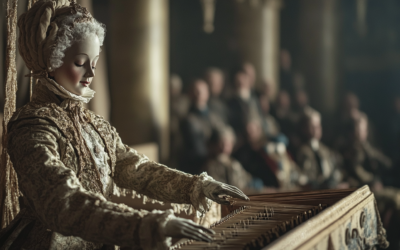Mozart's Symphonies
The Hidden Legacy of Michael Haydn
The persistent misattribution of works between Michael Haydn and Wolfgang Amadeus Mozart reveals a story of rivalry, imitation, and misrepresented genius. Even the famous Symphony No. 37 in G Major K.444, long considered a Mozart masterpiece, stands today as a testament to an intricate web of musical borrowings and historical misconceptions. As it turns out,
Mozart merely added an introduction to Haydn’s symphony, yet this was enough for it to remain falsely attributed to him for decades.
Such instances provoke questions about Mozart’s true originality and his family’s dismissive attitude toward the accomplished Michael Haydn.
Mozart: The Fall of the Gods
This book offers a fresh and critical look at the life of Wolfgang Amadeus Mozart, challenging the myths that have surrounded him for centuries. We strip away the romanticised image of the “natural genius” and delve into the contradictions within Mozart’s extensive biographies. Backed by nearly 2,000 meticulously sourced citations, this work invites readers to explore a deeper, more complex understanding of Mozart. Perfect for those who wish to question the traditional narrative, this biography is a must-read for serious music lovers and historians.
"How can one proclaim Mozart's originality when so much of his success relied on the brilliance of Michael Haydn?"
Mozart: The Fall of the Gods
Unveiling the True Composer Behind the Notes
The Illusion of Originality
The path of confusion over authorship winds through Mozart’s symphonies, culminating even with the acclaimed Jupiter Symphony, K.551. Its anonymous manuscript, still housed in the Biblioteca Estense in Modena, continues to be overlooked in modern critical studies. Yet, the most perplexing case remains Symphony No. 37 in G Major, K.444. Once celebrated as an authentic Mozart composition, it later emerged as a mere embellishment upon Michael Haydn’s Symphony No. 25, dated 23 May 1783. Mozart’s only contribution? A brief Adagio maestoso before Haydn’s Allegro movement.
A Legacy of Borrowing
Mozart’s alterations to Haydn’s original symphony went beyond the mere addition of an introduction. He modified the central Andante sostenuto, stripping away the bassoon part, arguably diminishing its richness. Historians have postulated that Mozart might have copied Haydn’s work to better understand his style, or as a tribute to the elder composer. Yet, the removal and adaptation suggest a more complex intent—an effort to make Haydn’s symphony less recognisable. Even today, musicologists struggle to accept that this was more than a homage. No evidence from letters, concert programs, or noble diaries ever credits Michael Haydn.
The Unacknowledged Influence
Mozart’s dependence on Michael Haydn’s compositions surfaces repeatedly. While Mozart’s supporters frame these borrowings as reverent, the letters between Wolfgang and his family tell a different story. For instance, a young Mozart wrote from Naples in 1770, anxiously requesting minuets by Haydn. He not only copied them but openly wondered if they had been “stolen.” Despite his supposed reverence, he pleaded for more minuets, openly mocking Haydn’s work in correspondence.
The Mozart family’s disdain for Michael Haydn intensified over time, painting him as an unreliable drunkard. Leopold Mozart even referred to Haydn as one of the “asinine” musicians of Salzburg. Despite this, Wolfgang relied on Haydn’s compositions, even for performances in Vienna. One has to wonder—if Mozart was such a master of counterpoint, why did he need to borrow fugues from Haydn?
Reassessing Mozart’s Musical Inheritance
The catalogue of music misattributed to Mozart is extensive. Works like the Adagio and Fugue in D Major (K.291) and various sacred compositions were lifted from Haydn, either wholly or in part. The letters reveal a pattern of plagiarism, mockery, and opportunism. The famous request for Haydn’s Tres sunt and the Lauda Sion—which ended up in the Köchel catalogue under Mozart’s name—only reinforce this narrative. The myth of Mozart as an unassailable genius collapses when faced with the evidence of his extensive borrowing from a composer his family ridiculed.
A Final Irony
In the end, Michael Haydn remains an unsung hero, a composer whose works formed the bedrock of Mozart’s supposed achievements.
You May Also Like
When the Myth Collapsed
Vienna exposed the myth: La Finta semplice was riddled with errors, and Wolfgang’s supposed opera genius was nothing more than Leopold’s fabrication. With their reputation in ruins, father and son turned to Italy, hoping to rewrite history.
The London Notebook and the Vienna Disaster
Far from the myth of a flawless young genius, Mozart’s London Notebook reveals musical struggles and guided exercises, while the Vienna opera disaster proved that his father played a far greater role in his compositions than legend would have us believe.
Versailles, Vanity, and the Pursuit of Prestige
Leopold Mozart’s letters transformed his son’s European tour into a carefully staged fantasy—filled with exaggerated encounters, fabricated royal admiration, and a relentless pursuit of social prestige. But how much of it was real?
The Fabricated Childhood of Mozart
The legend of young Mozart’s divine genius crumbles under scrutiny, revealing a childhood dictated by Leopold’s ambition, carefully constructed myths, and a relentless pursuit of fame at the expense of genuine artistic education.
The Man Behind the Myth
Leopold Mozart’s legacy has been shaped by myths and hagiographies, but his letters reveal a man more concerned with financial gain and self-promotion than artistic integrity. Was he truly a devoted father, or simply an opportunist?
Constanze vs. The Catholic Church
For over two centuries, scholars have debated the circumstances surrounding Mozart’s burial. Constanze Mozart’s supposed inability to mark his grave, the confrontation with the Catholic Church over funeral masses, and the baffling disappearance of Mozart’s body all contribute to a mystery stranger than fiction. Did a powerful group keep her silent? And what really happened to Mozart’s remains?







